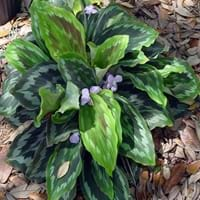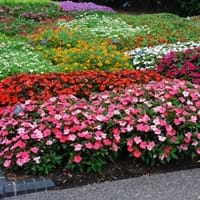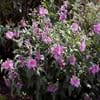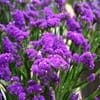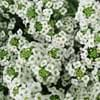Life Span
Annual
Annual and Perennial
Type
Tender Perennial
Tender Perennial
Origin
Southeastern Asia
Hybrid origin
Types
Not Available
not available
Habitat
Shady Edge
Subtropical climates, Tropical regions
USDA Hardiness Zone
8-12
9-15
AHS Heat Zone
12-10
12 - 1
Sunset Zone
H1, H2, 21, 22, 23, 24
H1, H2, 1a, 1b, 2a, 2b, 3a, 3b, 4, 5, 6, 7, 8, 9, 10, 11, 12, 13, 14, 15, 16, 17, 18, 19, 20, 21, 22, 23, 24
Habit
Clump-Forming
Clump-Forming
Flower Color
Purple, Lavender
White, Red, Orange, Pink, Salmon, Lavender
Flower Color Modifier
Bicolor
Bicolor
Fruit Color
Not Available
Green
Leaf Color in Spring
Green, Light Green
Yellow, Red, Green, Dark Green, Burgundy, Bronze
Leaf Color in Summer
Green, Dark Green
Yellow, Red, Green, Dark Green, Burgundy, Bronze
Leaf Color in Fall
Green, Dark Green
Yellow, Red, Green, Dark Green, Burgundy, Bronze
Leaf Color in Winter
Light Green
Light Green
Leaf Shape
Arrowhead
Ovate
Plant Season
Spring, Summer, Fall
Spring, Summer, Fall, Winter
Sunlight
Partial shade
Partial Sun, Partial shade
Type of Soil
Loam, Sand
Loam, Sand
The pH of Soil
Acidic, Neutral
Neutral
Soil Drainage
Well drained
Well drained
Bloom Time
Early Summer, Summer, Late Summer, Early Fall
Indeterminate
Tolerances
Drought
Drought
Where to Plant?
Ground
Container, Ground, Pot
How to Plant?
Divison, Tubers
Stem Planting
Plant Maintenance
Medium
Medium
Watering Requirements
Requires regular watering
Water when soil is dry
In Summer
Lots of watering
Ample Water
In Spring
Moderate
Average Water
In Winter
Average Water
Ample Water
Soil pH
Acidic, Neutral
Neutral
Soil Type
Loam, Sand
Loam, Sand
Soil Drainage Capacity
Well drained
Well drained
Sun Exposure
Partial shade
Partial Sun, Partial shade
Pruning
Remove damaged leaves, Remove dead branches, Remove dead leaves
Prune prior to new growth
Fertilizers
All-Purpose Liquid Fertilizer
Water soluble fertilizers
Pests and Diseases
Red blotch
Aphids, Caterpillars, Downy mildew, Gray mold, Leaf spot, Red blotch, Root knot nematode, Spider mites, Thripes, Whiteflies
Plant Tolerance
Drought
Drought
Flower Petal Number
Single
Single
Foliage Texture
Medium
Medium
Foliage Sheen
Matte
Glossy
Attracts
Not Available
Butterflies
Allergy
Not Available
Not Available
Aesthetic Uses
Ground Cover
Cottage Garden, Ground Cover, Showy Purposes
Beauty Benefits
Not Available
No Beauty Benefits
Environmental Uses
Air purification
Indoor Air Purification
Medicinal Uses
Carminative, Diuretic, Exoectorant, Pectoral, Stimulates new cell growth, Throat infection
No Medicinal Use
Part of Plant Used
Flowers, Leaves
Whole plant
Other Uses
Oil is used in perfume, soaps, creams, etc.
Used as Ornamental plant
Used As Indoor Plant
Yes
Yes
Used As Outdoor Plant
Yes
Yes
Garden Design
Container, Groundcover, Tropical
Bedding Plant, Container, Edging, Hanging Basket, Mixed Border, Tropical
Botanical Name
KAEMPFERIA elegans
IMPATIENS 'Fisnics Magpink'
Common Name
Peacock Ginger
Magic Pink New Guinea Impatiens, New Guinea Impatiens
In Hindi
Peacock Ginger
न्यू गिनी Impatiens
In German
Pfau Ingwer
Neu-Guinea Impatiens
In French
paon gingembre
Nouvelle-Guinée Impatiens
In Spanish
jengibre pavo real
Nueva Guinea Impatiens
In Greek
παγώνι τζίντζερ
Νέα Γουινέα Impatiens
In Portuguese
gengibre pavão
Nova Guiné Impatiens
In Polish
paw imbiru
Nowa Gwinea Niecierpek
In Latin
gingiberi pavo
Impatiens New Guinea
Phylum
Magnoliophyta
Magnoliophyta
Class
Liliopsida
Magnoliopsida
Order
Zingiberales
Geraniales
Family
Zingiberaceae
Balsaminaceae
Genus
Kaempferia
Impatiens
Clade
Angiosperms, Commelinids, Monocots
Angiosperms
Tribe
Not Available
Not Available
Subfamily
Not Available
Not Available
Number of Species
Not Available
Season and Care of Peacock Ginger and New Guinea Impatiens
Season and care of Peacock Ginger and New Guinea Impatiens is important to know. While considering everything about Peacock Ginger and New Guinea Impatiens Care, growing season is an essential factor. Peacock Ginger season is Spring, Summer and Fall and New Guinea Impatiens season is Spring, Summer and Fall. The type of soil for Peacock Ginger is Loam, Sand and for New Guinea Impatiens is Loam, Sand while the PH of soil for Peacock Ginger is Acidic, Neutral and for New Guinea Impatiens is Neutral.
Peacock Ginger and New Guinea Impatiens Physical Information
Peacock Ginger and New Guinea Impatiens physical information is very important for comparison. Peacock Ginger height is 15.20 cm and width 25.40 cm whereas New Guinea Impatiens height is 15.20 cm and width 20.30 cm. The color specification of Peacock Ginger and New Guinea Impatiens are as follows:
Peacock Ginger flower color: Purple and Lavender
Peacock Ginger leaf color: Green and Light Green
New Guinea Impatiens flower color: White, Red, Orange, Pink, Salmon and Lavender
- New Guinea Impatiens leaf color: Yellow, Red, Green, Dark Green, Burgundy and Bronze
Care of Peacock Ginger and New Guinea Impatiens
Care of Peacock Ginger and New Guinea Impatiens include pruning, fertilizers, watering etc. Peacock Ginger pruning is done Remove damaged leaves, Remove dead branches and Remove dead leaves and New Guinea Impatiens pruning is done Prune prior to new growth. In summer Peacock Ginger needs Lots of watering and in winter, it needs Average Water. Whereas, in summer New Guinea Impatiens needs Ample Water and in winter, it needs Ample Water.
